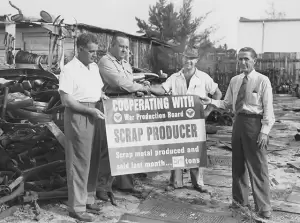Local Response: Blackout Restrictions

Lights from homes and businesses on land would create silhouettes of the Allies’ supply ships, making them easy targets for German U-boats. To discourage attacks, streetlights were covered to allow only a small light cast straight downward. Automobile headlights were dimmed and covered with tape, which was also used in homes to hold curtains closed. Schoolchildren “knitted for Britain” before the U.S. entered the war, and collected scrap metal and rubber to recycle.
The U.S. Government issued blackout restrictions along the East Coast, enforced by Civil Defense wardens. Following is the blackout order for Palm Beach from April 11, 1942:
By Official Order of Governor Spessard L. Holland and the Commanding Officer at Key West, Florida:
You are hereby requested to take the following steps to comply with the recent blackout order carried in the press.
- It is requested that you immediately take steps to have extinguished all street lights on water front streets and highways at once, and those actually on the ocean front, not those on the west side.
- Screen water front sidelights on all streets running down to the waterfront for about four (4) city blocks away.
- Screen all advertising lights and lighted windows near beachfront that are facing seaward and are directly visible from off shore.
- Screen all bright lights on seawards side, directly visible from the sea, and within two (2) miles from the waterfront, this again does not apply to those low-lying lights on the mainland that maybe already screened by invisible objects.
- In case of a brightly lighted installation near beach have the light so directed and screened so that no direct light can be seen from off shore.
By Order of the:
Palm Beach Civilian Defense Council
O.B. Carr, Executive Director

